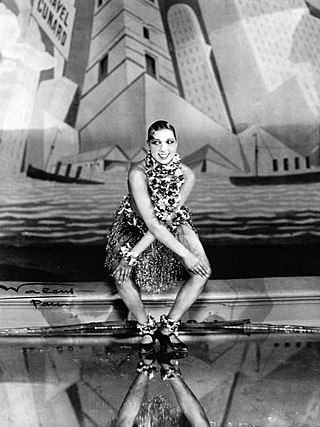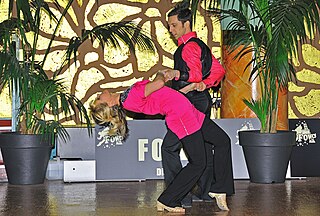Related Research Articles

East Coast Swing (ECS) is a form of social partner dance. It belongs to the group of swing dances. It is danced under fast swing music, including lindy hop, rock and roll and boogie-woogie.
Nightclub two step is a partner dance initially developed by Buddy Schwimmer in the mid-1960s. The dance is also known as "Two Step" and was "one of the most popular forms of contemporary social dance" as a Disco Couples Dance in 1978. It is frequently danced to mid-tempo ballads in 4
4 time that have a characteristic quick-quick-slow beat. A classic example is the song Lady In Red.
The Carolina shag is a partner dance done primarily to beach music. Today, the shag is a recognized dance in national and international dance competitions.

The Charleston is a dance named after the harbor city of Charleston, South Carolina. The rhythm was popularized in mainstream dance music in the United States by a 1923 tune called "The Charleston" by composer/pianist James P. Johnson, which originated in the Broadway show Runnin' Wild and became one of the most popular hits of the decade. Runnin' Wild ran from 28 October 1923, through 28 June 1924. The peak year for the Charleston as a dance by the public was mid-1926 to 1927.

West Coast Swing is a partner dance with roots in the Lindy Hop. It is characterized by an elastic look that results from its extension-compression technique of partner connection and is danced primarily in a slotted area on the dance floor. The dance allows for both partners to improvise steps while dancing together, putting West Coast Swing in a short list of dances that emphasize improvisation.
Dance moves or dance steps are usually isolated, defined, and organized so that beginning dancers can learn and use them independently of each other. However, more complex movements are influenced by musicality and lyrical relevance to express emotions or refer to a message. Dance moves tend to emphasize the concepts of lead and follow and connection.

Swing dance is a group of social dances that developed with the swing style of jazz music in the 1920s–1940s, with the origins of each dance predating the popular "swing era". Hundreds of styles of swing dancing were developed; those that have survived beyond that era include Lindy Hop, Balboa, Collegiate Shag, and Charleston. Today, the best-known of these dances is the Lindy Hop, which originated in Harlem in the early 1930s. While the majority of swing dances began in African-American communities as vernacular African-American dances, some influenced swing-era dances, like Balboa, developed outside of these communities.

Salsa is a Latin dance, associated with the music genre of the same name, which was first popularized in the United States in the 1960s in New York City. Salsa is a mixture of Cuban dances, such as mambo, pachanga, and rumba, as well as American dances such as swing and tap.
Modern Jive is a dance style derived from swing, Lindy Hop, rock and roll, salsa and others, the main difference being the simplification of footwork by removing syncopation such as chasse. The term "French Jive" is occasionally used instead, reflecting the origins of the style, as is the term "Smooth Jive". The word "modern" distinguishes it from ballroom Jive.
This is a list of dance terms that are not names of dances or types of dances. See List of dances and List of dance style categories for those.
The Hustle is a catch-all name for some disco dances which were extremely popular in the 1970s. Late 1970s, Bump, Hustle, Watergate and Spank were popular. It mostly refers to the unique partner dance done in nightclubs to disco music. Hustle has steps in common with Mambo and Salsa and basic steps are somewhat similar to Euro dance style "discofox", which emerged at about the same time and is more familiar in various European countries. Modern partner hustle is sometimes referred to as New York hustle, however, its original name is the Latin hustle.
The basic step, basic figure, basic movement, basic pattern, or simply basic is the dance move that defines the character of a particular dance. It sets the rhythm of the dance; it is the default move to which a dancer returns, when not performing any other moves. More formally, it can be defined as a "rhythmic step pattern" in the form of a "consistent and recurring grouping of weight changes" between the feet which is rhythmic and repeated for the length of a song. For some dances it is sufficient to know the basic step performed in different handholds and dance positions to enjoy it socially.
A Coaster Step is a term used in swing dancing which originated in Lindy swing. During the last two beats of a rhythm pattern, the follower rotated 90° to be perpendicular to the leader, then stepped back, together, and forward in triple-rhythm, then rotated back to face the leader and to be ready to step forward as the leader led the follower in to begin the next pattern.

The cha-cha-cha, is a dance of Cuban origin. It is danced to the music of the same name introduced by the Cuban composer and violinist Enrique Jorrin in the early 1950s. This rhythm was developed from the danzón-mambo. The name of the dance is an onomatopoeia derived from the shuffling sound of the dancers' feet when they dance two consecutive quick steps that characterize the dance.
The country/western two-step, often called the Texas two-step or simply the two-step, is a country/western dance usually danced to country music in common time. "Traditional [Texas] two-step developed, my theory goes, because it is suited to fiddle and guitar music played two-four time with a firm beat [found in country music]. One-two, one-two, slide-shuffle. The two-step is related to the polka, the Texas waltz, and the jitterbug.
The Texas two-step is the same step known to ballroom dancers as the international fox-trot. Except for the one-step, which is just that, most Texas dances are variations of a two-step, also called a half-step, which is simply a step-close-step. The Texas two-step is generally done with two long steps and a step-close-step to two-four time. Speeded up, it's a shuffle or double shuffle, but still a two-step.
Zydeco as a dance style has its roots in a form of folk dance that corresponds to the heavily syncopated zydeco music, originated in the beginning of the 20th century among the Francophone Creole peoples of Acadiana. It is a partner dance that has been primarily danced socially and sometimes in performances.
Rock step may refer to one of several similar dance moves. The name refers to the rocking action during the move: the weight is transferred from one foot to another and then back. It is used in a number of dances, such as East Coast Swing, Zydeco, Lindy Hop, Tango.
Chicago-Style Stepping is an urban dance that originated in Chicago and continues to evolve nationwide and overseas, while defining its unique style and culture. within urban community. "Chicago-Style Stepping" makes reference to other urban styles of dance found throughout the United States in urban enclaves such as Detroit, Cleveland, Baltimore and Washington, D.C.
The Collegiate Shag is a partner dance done primarily to uptempo swing and pre-swing jazz music. It belongs to the swing family of American vernacular dances that arose in the 1920s and 30s. It is believed that the dance originated within the African American community of the Carolinas in the 1920s, later spreading across the United States during the 1930s. The shag is still danced today by swing dance enthusiasts worldwide.
References
- ↑ http://www.westcoastswings.com/index.php/12-basic-dance-guidelines Archived 2016-08-20 at the Wayback Machine West Coast Swing Basic Guidelines.
- ↑ http://www.swingworld.com/dance_dictionary.htm Archived 2009-03-17 at the Wayback Machine Skippy Blair's Dance Dictionary
- ↑ "DANCE DICTIONARY "Terminology"". 17 March 2009. Archived from the original on 17 March 2009.
{{cite web}}: CS1 maint: bot: original URL status unknown (link) - ↑ Swing Dance Encyclopedia. Thomas L. Nelson. 2008. second edition. Authorhouse. page 6.2. ISBN 978-1-4343-5960-5